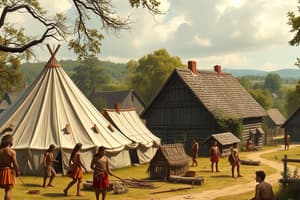Podcast
Questions and Answers
Leif Eriksson was the first known European to explore North America before Christopher Columbus.
Leif Eriksson was the first known European to explore North America before Christopher Columbus.
True (A)
European settlers brought diseases that Native Americans had immunity to.
European settlers brought diseases that Native Americans had immunity to.
False (B)
As many as 95% of Native Americans died due to diseases from European settlers.
As many as 95% of Native Americans died due to diseases from European settlers.
True (A)
Initially, Native American nations and European settlers had a harmonious relationship based on trade.
Initially, Native American nations and European settlers had a harmonious relationship based on trade.
European settlers frequently encountered hostile Native Americans upon their arrival.
European settlers frequently encountered hostile Native Americans upon their arrival.
The arrival of Europeans caused Native Americans to adjust their hunting practices, impacting their gender balance.
The arrival of Europeans caused Native Americans to adjust their hunting practices, impacting their gender balance.
Many Native American cities were left empty due to the arrival of European settlers and their diseases.
Many Native American cities were left empty due to the arrival of European settlers and their diseases.
European explorers only came to America to establish peaceful trade relations.
European explorers only came to America to establish peaceful trade relations.
Native Americans commonly practiced communal land ownership.
Native Americans commonly practiced communal land ownership.
European colonists never broke treaties made with Native Americans.
European colonists never broke treaties made with Native Americans.
By the 1600s, three distinct groups of immigrants settled in the United States.
By the 1600s, three distinct groups of immigrants settled in the United States.
Indentured servants made up less than 1/3 of the European immigrants who came to American colonies.
Indentured servants made up less than 1/3 of the European immigrants who came to American colonies.
The understanding of land ownership was similar between Native Americans and Europeans.
The understanding of land ownership was similar between Native Americans and Europeans.
Native American nations often struggled to win wars against Europeans and Americans due to various disadvantages.
Native American nations often struggled to win wars against Europeans and Americans due to various disadvantages.
Economic immigrants were primarily seeking land ownership and farming opportunities in the New World.
Economic immigrants were primarily seeking land ownership and farming opportunities in the New World.
Forced immigrants included people who were compelled to work for others in exchange for passage to the New World.
Forced immigrants included people who were compelled to work for others in exchange for passage to the New World.
Flashcards are hidden until you start studying
Study Notes
The First Immigrants to the United States
- Native Americans, also known as American Indians, were the original inhabitants of the area now known as the United States.
- European exploration began in the late 1400s, primarily by Spaniards and Portuguese.
- Leif Eriksson was the first known European to explore North America, predating Columbus by nearly 500 years.
- Christopher Columbus's voyages starting in the 1490s led to an influx of explorers from various European nations.
- French, English, and Dutch explorers followed Columbus, with motivations ranging from exploration to conquest.
- By the mid-1500s, Europeans started colonizing the area, introducing new plants, animals, ideas, technology, and diseases.
- Native Americans lacked immunity to European diseases, resulting in an estimated 95% mortality rate among them, equating to about 60 million deaths.
- The dramatic decline in Native American populations contributed to global cooling due to reduced human activity and land use.
- Many encounters between European settlers and Native Americans occurred in largely empty areas rather than hostile scenarios.
- Initial relations included beneficial trade, but increased European settlement strained relationships and altered tribal dynamics, particularly impacting gender roles.
- Different perceptions of land ownership caused conflicts: Native Americans viewed land as communal, while Europeans favored individual ownership and transactions.
- Numerous treaties were signed that promised respect for Native American sovereignty, but these were frequently violated by future colonists.
- Native Americans were progressively forced onto smaller reservations containing less desirable land through a cycle of broken treaties.
- From the late 1500s to the 1800s, Native American nations engaged in wars against European and later American forces to preserve their lifestyles.
- Immigrant groups in the emerging United States in the 1600s included economic, religious, and forced immigrants.
- Economic immigrants aimed to improve their financial situation, with a significant portion being indentured servants (up to two-thirds of European immigrants between the 1630s and the American Revolution).
- Religious immigrants sought the freedom to practice their faith, contributing to the religious diversity in early American society.
Studying That Suits You
Use AI to generate personalized quizzes and flashcards to suit your learning preferences.




